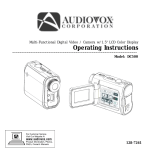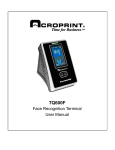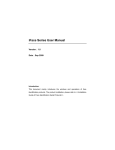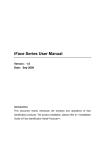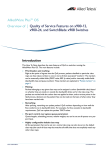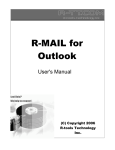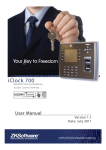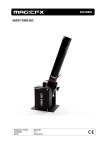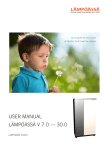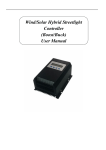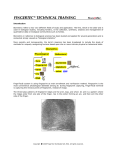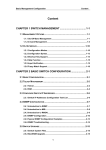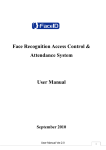Download User Manual - Automate My Attendance
Transcript
User Manual Version 1.1 Date: November 2011 Table of contents 1 Getting started 3 1.1 Position, Posture and Facial Expressions 1.2 Enrolment Facing Directions . . . . . 1.3 Fingerprint Placements . . . . . . . 1.4 Correct usage of Touch Screen. . . . 1.5 Touch Keypad Operation . . . . . . 1.6 Main Interface . . . . . . . . . . . 1.7 Verification Modes . . . . . . . . . 1.7.1 Fingerprint Verification Mode . . . 1.7.2 Face Verification Mode . . . . . 1.7.3 Password Verification Mode . . . . . . . . . . . . . . . . . . . . . . . . . . . . . . . . . . . . . . . . . . . .3 .3 .3 .4 .4 .5 .5 .5 .6 .7 2 Main Menu 8 3 User Management 9 3.1 Add User . . . . . . 3.1.1 Input User ID . . . 3.1.2 Input Name . . . 3.1.3 Enrol Fingerprint . . 3.1.4 Enrolling Face . . 3.1.5 Enrolling Password . 3.1.6 User Priviledges . . 3.2 Edit User. . . . . . . 3.3 Delete User . . . . . 3.4 User Search . . . . . 4 . . . . . . . . . . . . . . . . . . . . . . . . . . . . . . . . . . . . . . . . . . . . . . . . . . . . . . . . . . . . . . . . . . . . . . . . . . . . . . . . . . . . . . . . . . . . . . . . . . . . . . . . . . . . . . Communication Settings .9 .9 10 11 11 12 12 12 13 13 13 4.1 Configure Networks . . . . . . . . . . . . . 14 4.2 Configure Serial Port . . . . . . . . . . . . 14 4.3 Configure Wiegand . . . . . . . . . . . . . 14 5 System Settings 5.1 Basic Parameter . . . 5.2 Inteface Parameter . . 5.3 Fingerprint Parameter . 5.4 Face Specification . . 5.5 Log Settings . . . . . 5.6 Update . . . . . . . 15 . . . . . . . . . . . . . . . . . . . . . . . . . . . . . . . . . . . . . . . . . . . . . . . . . . . . . . . . . . . . . . . . . . 15 16 16 17 17 17 I-2 Table of contents...continue 6 Data Management 18 7 USB Drive Management 18 8 Keyboard Settings 18 9 Auto Test 19 10 Screen Calibrating 20 11 Scheduled Bell Settings 20 12 Access Control Settings 21 13 System Information 21 13.1 Record Capacity . . . . . . . . . . . . 21 13.2 Device Information . . . . . . . . . . . 21 14 Appendix 22 14.1 Intruction of Text Input . . . . . . . . . . 22 14.2 Rules for uploading photo. . . . . . . . . 23 I-2.1 Summary 1. Getting Started 1.1 Position, Posture and Facial Expressions Recommended installation and standing distance: * Please ensure correct installation procedures. For users 5-6 feet tall (1.5m-1.85m) we recommend * Take note of the position, posture and facial expressions. users stand about 2 feet (0.5m) from the wall. When viewing your image on the device display window, step away if your image appears too bright. Step closer if your image appears too dark. Recommended Facial Expressions VS Non-Recommended Expressions: Recommended Posture VS Non-Recommended Posture: 1.2 Enrolment Facing Directions During the enrolment, position your head such way that your face appears in the center of the device display window. The device will prompt you how to move your head. Follow the voice prompts by first gently turning your head : * Take note: variations are slight movements * The slight variations of the head angles will help the device to better recognize your face when you attempt to verify. 1.3 Fingerprint Placement Recommended fingers: The index finger, middle finger or the ring finger; the thumb and little finger are not recommended (because they are usually clumsy on the fingerprint collection screen). Please enrol and verify your fingerprint by using the proper finger placement mode. We shall not be held accountable for any consequences arising out of the degradation in verification performance due to improper user operations. We shall reserve the right of final interpretation and revision of this document. including the installation guide, access control software user manual. 3 * Ensure correct fingerprint placements. Summary 1.4 Correct usage of Touch Screen Touch the screen with one of your fingertips or the edge of a fingernail, as shown in the following figure. A broad point of contact may lead to inaccurate pointing. * Ensure correct usage of the touch screen. When the touch screen is less sensitive to the touch, you can perform a screen calibration through the following menu operations. 1. Press [Menu] -> [Auto Test] -> [Calibration] on the screen and a cross icon will be displayed. After you touch the center of the cross at five locations on the screen correctly, the system will automatically returns to the main menu. 2. Press [Exit] to return to the initial interface. * Calibration is recommended for correct usage of touch screen Smear or dust on the touch screen may affect the performance of the touch screen. Therefore, try to keep the screen clean and dust-free. 1.5 Touch Keypad Operation 1) Enter a number. Click[ID No], the system will automatically popup digital input interface. After entering the figures, click[OK]to save and return to the previous interface. 2) Input characters. Click [Name] button, the system will automatically popup text entry interface, after entering the text, press [X] key to save and return to the previous interface. 3) Modified parameters. Click t the default parameters from the system, it will automatically switch other parameters. 4 * Detailed explanation: see appendix 1. Summary 1.6 Main Interface * Ensure to familiarise main menu. 1 - (8) Screen shortcut key and (9) Keypad shortcut key are one to one correspondence. Users can customize the shortcut keys for each function, the specific operation method refers to the introduction on ‘8 keyboard definition’. 2 - (7) Showing Facial picture, it means the current device on facial identification mode. (7) Showing Fingerprint picture, it means the current device on fingerprint identification mode. Users could change the identification mode through operation to (5) Fingerprint/Facial identification switch key (8) Screen shortcut key or (9) Keypad shortcut key 1.7 Verification Modes 1.7.1 Fingerprint Verification Mode 1.7.1.1 1: N Fingerprint Verification Under the fingerprint authentication mode, the fingerprint that are used will be compared to the fingerprint data in the device. 1. Fingeprint authentication modes: 1. Press the [Fingerprint/Face identification switch] 2. Click the [fingerprint/Facial] short cut key on the screen. 3. Click the [fingerprint/Facial] short cut key on the screen. * 1 : N - One to Many (the system compares your fingerprint to all other fingerprints on the system. 2. Successful verification, see the interface on above picture (right) 3. Failure verification, see the interface picture on the right * Successful and unsuccessful verification 5 Summary 1.7.1.2 1: 1 Fingerprint Verification 1:1 Fingerprint Verification The fingerprint that are used will be compared to the fingerprint which related to user number in the device .This method is used when the user’s fingerprint identification is difficult to process. * 1 : 1 - One to One (the system compares your fingerprint to the user id entered before verification) 1.There are thress ways to inter the fingerprint authentication mode (as show left) : 1)Click the [1:1/1:G]on the screen. 2)Click the[1:1/1:G]s creen short cut key 3)Click the shortcut key corresponding to the key board. Note: The last two kinds of methods could be available after the “1:1 / 1: G” was set to shortcut keys. See the introduction to ‘Keyboard Definition’ 2. In the popup keyboard interface, enter the user ID, and then click the “fingerprint” icon (below), enter the 1:1 fingerprint patterns. If prompted to “nonregistered users!” Indicating the number does not exist or the number of employees is not a registered fingerprint. 1.7.2 Face Verification Mode 1:G Facial verification Face recognition interface displays the current group number; the current group of users can make directly face comparison. When making user authentication of other groups, It must enter the group number or use the shortcut keys to select the group number, and then make a comparison with human faces, the system is set to sync the group as the current group. 1.The three ways to inter the 1 :G authentication mode (as show left) : 1. Click the [1:1/1:G] bottom on the screen (left 1) 2. Click the[1:1/1:G] shortcut key on the screen 3. Click the shortcut key which corresponding to the keyboard Note : The last two kinds of methods could be available after the “1:1 / 1: G” was set to as shortcut keys. See the introduction to ‘Keyboard Definition’ 2.In the popup keyboard interface, enter the group number, and then click the “1: G” icon (below right), enter the 1: G fingerprint patterns. 6 * Use 1:1 when it’s difficult to recognise the face in normal 1:N mode. 3.Please adopt the right pose to make facial verification. See the introduction on ‘1.1 standing situation ,standing position and countenance’ Summary 4: Successful identification (below) * Password may contain numbers ranging from 1 - 8 digits. 1.7.3 Password Verification Mode The input password should be compared to the related user number . 1. There are 3 ways to inter the password verification mode: 1. Click the[1:1/1:G]bottom on the screen 2. Click the [1:1/1:G] shortcut key on the screen 3. Click the shortcut key from the keyboard. Note : The latter two kinds of methods could be available after the “1:1 / 1: G” was set to shortcut keys. See the introduction to ‘Keyboard Definition’ 2. In the popup keyboard interface, input the user number and click the “key” icon to enter password verification model (left 2) If prompted to “nonregistered users!” Indicating the number does not exist or the number of employees is not registered fingerprint 3. In the popup keyboard interface , input the password and press the “OK” icon to make the password comparison 4. Successful verification interface ,see below * Ensure correct pin usage 7 2. Main Menu Summary Staff has two kinds of privileges: users and administrators. Users can only use face, fingerprint or password authentication; administrator can enter the main menu to operate all kinds of settings together with the “User” functions. In the initial interface, you can press [MENU] key to enter the main menu, as shown below: * Access main menu * Endure to enrol administrator for security purposes IIf the device does not have administrator, any person presses [MENU] key ey to be able to enter the menu operation; if an administrator is enrolled, it will need administrator confirmation to enter the menu. For the safety sake, it is recommended enrolling administrator for the first time of using. Main menu has 10 sub-menus and three shortcut keys as shown below: System Info Date & Time Add user The main menu includes nine sub menus: User: View personnel information, including ID No., name, fingerprint, face, cards, passwords, privilege and group of the unit and so on. Increase, edit or delete operation the basic information. Connection.: Set up communication parameters between the equipment and the PC, including IP address, gateway, subnet mask, baud rate, device number, communications password etc.. System.: Set the system parameters, including basic parameters, interface parameters, fingerprints, face and attendance parameters, to maximize meet user’s needs in the functional, display and other areas. Data: Manage the data in the device, such as delete attendance records, delete all the data, clear administer privilege, clear publicity pictures and restore the factory settings. USB: By USB, the user info and attendance data etc. can be imported to the accordingly software to manage the user info, or transfer to other fingerprint devices. Keyboard: Customize the 6 shortcut keys; press the status button to display the corresponding state. Auto Test: Automatically test the function of each module if it’s working, including the screen, sensor, voice, face, keyboard and clock tests. Bell: Set the time and ringing duration of the scheduled bell. Access: Set the parameters of locks controlled and related access control device. Calibration: When touchscreen response is not sensitive, enter the calibration interface to adjust. 8 * Ensure to be familiar with menu and functions. 3. User Management Summary Browse personnel information, including ID No., name, fingerprint, face, cards, passwords, privilege and group of the unit and so on. Increase, edit or delete the basic information. In the main menu interface, press [User Management] to enter the usermanagement interface. * If administrtor is enrolled, option will only be available for administrtor. 1. Back to Menu 2. Query User 3. Add User 4. Scroll 5. User info list 6. Choose the letters 3.1 Add User In the user management interface, press [Add] button to enter add user Interface as shown below: * Enrolment of users • User ID: Input employee’s ’ ID N No. Th The d default f lt di digit it iis 1 1~ 8 8. • Name: Enter a user name. 12 characters user names are supported by default. • Fingerprint: Enroll a user’s fingerprint and the device displays the number of enrolled fingerprints. A user can enroll 10 fingerprints at maximum. • Password: Enroll a user’s password. The device supports 1-8 digit passwords by default. • Card: Enroll a user’s card • Face: Enroll a user’s face. • Group No.: Set the group that the user belongs to. Valid group No.: 1-24. • Users: Set the rights of a user. A user is set to ordinary user by default and can also be set to administrator. Ordinary users are only granted the rights of face, fingerprint or password verification, while administrators are granted access to the main menu for various operations apart from having all the privileges granted to ordinary users. * Options available for when enrolling a user. 3.1.1 Input ID no. The device allocate ID No automatically to employee, started from 1. If use the device automatically allocation ID No, this section could be skipped. 1.In Add Users interface,press [ID No.:1] button to enter the w ID No Setting interface, see the left Image 1: Tips: You can modify the ID No. at the first enrollment. When the enrollment is completed, the ID No. could not be modified. 9 * Enter alternative user ID Numbers Summary 2.In the popup keyboard interface, Input user’s ID No., then click “OK” button, (If you are prompted “ID No. already exists!” means the No. are already in use, then input the other no.) Tips: The default ID No. digit is 1 to 9. If need to extend the digit, please contact our Business Representative or presales technical support. 3. ID No. input is completed, see the left Image 3. Press [Save] button to save the current information and back to the previous interface; press [User] button not to save the current information, and directly back to the previous interface. 3.1.2 Input name Use keyboard to input employee’s name. 1:In Add Users interface, press [Name] to enter the name input interface, see the left Image 1. 2.In the popup keyboard interface, enter user’s name and then click the “X” button, see the left Image. For the operation of the keyboard interface, see “Keyboard Help”. Tips: The Device default name digit is 1~ 12. * Detailed explanation of keyboard - see appendix 1 3. Name input is complete, see the left Image3. Press [Save] button to save the current information and back to the previous interface; press [User] button not to save the current information, and directly back to the previous interface. 10 Summary 3.1.3 Enrolling a Fingerprint 1:In Add Users interface, press [Fingerprint] button to enter the interface , see the Image 1. In the popup fingerprint Enrollment interface, follow the screen tips, press finger on the sensor in the right way. See “1.1 How to press finger”. * Ensure correct placing of finger. Press one finger 3 times in the proper way. If successes, the screen tips will show up(see the left Image 3)and will automatically back to the Add Users interface. If fail, the screen tips will show up and back to fingerprint Enrollment interface and redo the step 2. 1. Press [Fingerprint] to use other fingers to backup and 10 fingerprints can be enrolled at most. * Up to 10 fingers per user can be enrolled. 2. Press [Save] to save the info and back to the previous interface, or press [User] not to save and back to the previous interface. 3.1.4 Enrolling a Face 1. In Add Users interface, Press [Face] button to enter the face enrollment interface, see the left Image 1: 2. In the popup Face Enrollment interface (see left Image2), according to the voice tips to a small range around rotor, the rise , bow and other actions aimed at the different parts of the face all entering into the system, to make verification more accurate. See the iintroduction of “Verification posture” . 3. After enrolling successfully, screen 3 ttips will show up, and will automatically go back to the Add Users interface g ((see left Image 3). 11 * Ensure to follow instructions, and not to make big moverments. * Angles of diffirent facial reading is very small. Summary 3.1.5 Enrolling Password 1. In Add User interface, Press [Password] button to enter the password settings interface, see the left Image 1. 2:In the popup keyboard interface, input your password, then click “OK” button, see the left Image 2. According to the screen tips to input your password again, and then click “OK” button to save. Tip: Default password digits is 1-8 3. Password input is completed. Press 3 [Save] button to save the current information and back go to the previous inm tterface; press [User] button not to save tthe current information, and directly back to the previous interface. b 3.1.6 User privileges 1. In Add Users interface, press [User] button, you can change the user privilege to Administrators, see the left Image1. * Ensure correct procedure of adding an administrator. Note: Staff has two kinds of privileges:users and administrators. Users can only use face, fingerprint or password authentication; administrator, owning the Users’ function and can also enter the main menu to operate all kinds of the settings. a 2. After completion of editing, see the 2 lleft image. Press [Save] button to save tthe current information and back to tthe previous interface; press [User] button not to save the current informab ttion, and directly back to the previous iinterface. 3.2 Edit User Please select any user from the user list, then enter the interface of editing user . The ID Number is not promised to modified ,and other operation the same as the rogress of register user .It is Ok to re-enrol the fingerprint ,face , password ,also modified the administration authority and the Group Number 12 Summary 3.3 Delete User 1. In the editing interface, Press [Delete],than enter the Setting Group Number interface as the picture. * Ensure correct user ID before deletion. 2. Press [Delete],the user information has been all delete; Press [back], then return to the previous interface. 3. In the editing the user interface, the press of the name, fingerprint, face, and password could delete the information as needed. 3.4 User Search While enrolled many users ,the management could find any user as need faster by the “ID Number” ,and “name” searches 1. In the user management interface, press the[Query] then entry the ID Number Query interface OR * 2 Options to search for uers. Name Search In the user management interface, press first letter of the user name in the letter list area “as the below picture. 2. Entering the ID in the new interface (picture left), press [OK ],then the user will show. 4. Communication Settings The setting of communication between the PC and equipment is including the IP address , gateway, subnet mask, baud rate, device number , signal code, and so on. 13 4.1 Configure Networks When the equipment connecting with PC by TCP/IP, please kindly check the settings below : Machine IP address: Default IP is 192.168.1.201, and it is ok to modify as needed ; Do not set IP address as same IP from PC that the device connected with. Subnet mask: Default mask 255.255.255.0, it is Ok to modify as needed. Summary * Note: Do not set IP address the same as connecting pc. * Settings may be changed as needed. Gateway address: the Default gateway address is 0.0.0.0, if the equipment and PC is not in the identical network segment, set up the gateway address firstly. 4.2 Configure Serial Port When connecting with the PC via RS232/485, please use settings below: RS232: When the RS232 is used, ensure the setting is set to “ON”; RS485: When the RS485 is used, ensure the setting is set to “ON”; Baud rate: The rate at which fingerprint machine communicate with the PC , there are five kinds of options 9600, 19,200, 38,400, 57,600, 1.15200 bit/sec, the high speed communication is faster ,and recommend for the RS232 communication ; The low speed communication is stable, and recommended for the RS485 communication; Connection password: To ensure the security of time and attendance databases , you could set the connection password . The system default password is 0(if the password does not exist), it is allowed to change to other values, after setting up, be sure to input this password before the software communicate with the equipment , otherwise you will fail to create connection between the fingerprint unit and PC software. The connection password length is 1 ~ 6. 4.3 Configure Wiegand Wiegand Format: The system has two built-in formats Wiegand 26-bits and Wiegand 34-bits, and also supports the format customization function to meet individualized requirements. 14 * Ensure correct option for client needs. * High Baud rate for RS232 * Low Baud rate for RS485 Failed ID: Refers to the value output by the system upon verification failure. The output format is subject to the setting of “Wiegand Format”. The default value scope of Failed ID is 0–65535. Summary Site Code: The site code is used for a customized Wiegand format. The site code is similar to the device ID, but the site code is customizable and can be duplicated among different devices. The default value scope of the Site Code is 0–255. Pulse Width: Refers to the width of the Wiegand pulse in microseconds. The default value scope of the pulse width is 1–1000. Pulse Interval: Refers to the interval of the Wiegand pulse in microseconds. The default value scope of the pulse width is 1–10000. Output: Refers to the contents output upon successful verification. You can select the “User ID” or “Card Number” as the output. 5. System Settings Client specific needs can be adjusted in the system settings. The following settings are avaiailable to change: interface parameter, fingerprint face , time and attendance parameters 5.1 Basic Parameter Date/Time: Setting the data and time of the equipment. Date Format: Setting the data format in the original interface Keyboard Beep: Setting the voice of keyboard. If “ON”, there will be beep .If “OFF, It will be not Voice : Setting the equipment with voice : If “ON”, there will be voice .If “OFF, It will be not Volume(%): Setting the volume of the voice Power key: Setting the power key of equipment . While the “ON”, the power key will be will be invalid. While the “OFF”, the quipment will be closed after pressed power key 3 seconds. 15 * Ensure correct settings as per client specifications Summary 5.2 Interface Parameter * Personal and display settings Language: To change and set the language. Display Style: Setting the display of the Initial Interface. Two modes “Clock screen” and “Full screen” as option. Toolbar Style: The Style of the Initial Interface shortcuts. 2 styles :”Auto hide” and “Always Display” as option . 1. “Auto hide”: Status bar could show and hide by setting ; 2.“Always Display”, the status bar will show in the Initial Interface forever. Default Verify Mode: Two default modes: 1. Fingerprint 2. Face Pictures Delay: Setting a period about the change of the picture. (supporting 3-999 seconds) Sleep Time: When device is not in operation, it will enter sleepmode (according to settings). With a keystroke of fingerprint, the system will exit sleep mode. 5.3 Fingerprint Parameter * Low threshold: slower reading, more accurate 1: 1 matching threshold: User ID + FP (lower threshold for higher secu security) * High threshold: faster reading, less accurate 1: N matching threshold: Higher threshold for this function, due to speed. 1:1 reorganization repeat times: while adopt the 1:1 or the Password. The equipment will be Ok to repeated identification for the user after failed identification .eg: Unenrolled fingerprint ,and the fingerprint touch is not good. Algorithm Version: There are two fingerprint algorithm version 9.0 and10.0 as option for the customers. Please kindly notice: the fingerprint templates from algorithm version 9.0 and10.0 is incompatiable. The fingerprint image display: There are tow options: Display forever and No display , Please kindly choose as you need so that the fingerprint image to show or not in the display while enrolled or reorganization. 16 * Algorithms: V9 and V10 are not compatible, ensure correct enrolment and verification. Summary 5.4 Face Specification * Ensure verification mode corresponds to the threshold as needed by client and amount of staff. 1: 1 matching threshold: User ID + Face (lower threshold for higher se security) 1: N matching threshold: Higher threshold for this function, due to speed. Enrol Mode: Setting user enrol mode.There are two modes, combined Enrol and face. If you choice “combined enrol” ,after you enrol face, you must enrol fingerprint or password. If you choice “face”,you only need enrol face. This option is invalid for admin. The terminal set “combined enrol” to admin. Enrol way : The way of registration for the new user by face . Exposure: Set the value of Exposure. Gain: Set the value of Gain. Quality: Set the value for matching facial module 5.5 Log Settings * Ensure to keep logs backup up, and not overflowing the limit. Log Alert: When the remaining aining log is less than the number setting setting, th the device will alert automatically( Valid setting:199). ReCheck Time(M): Within the time setting(Unit: Minute) Card Only: “Yes” means only card authentication is OK. “NO” means after card authentication, the user should do a fingerprint authentication. 5.6 Update Using this function to update the firmware from USB drive. 17 6. Data Management Summary Delete Transactions: Delete all logs in the device. Delete All Data: Delete all data, including user information, fingerprints, face and logs. * Ensure correct function be fore deleting data or information. Clear Administrator: Clear Administrator privilege of all the admininistrator. Delete Picture: Delete all the pictures uploaded from USB. Reset All Default Settings: Reset all the Parameter to default settings. Workcode: Reset all workcodes 7. USB Drive Management Download Transactions: Download all logs in the device to the USB drive. Download User: Download all user information, fingerprint templates and Facial templates to the USB drive. Download User photos: Download registered user id photos Upload User: Upload all user information, fingerprint templates and Facial templates from USB drive to the device. Upload Photo: Upload the JPG file named by user ID from USB drive to the device. When the user identify successfully, the picture appears. Upload Picture: Upload the JPG file which the name start with “ad_” from USB drive to the device. These picture will appear on the initial interface. 8. Keyboard setting Define F1-F6 as shortcut key, such as Time attendance status key, function shortcut key etc. On the initial interface, press the shortcut key, then go to the selected function interface. 1. On the main interface, press [keyboard] button, then go into the keyboard setting interface. 18 * Ensure correct USB stick are used, and test data before transferring. Summary On the keyboard setting interface, press “add” key to add a new shortcut key. Press the existing shortcut entry to modify the shortcut key. 3. Shortcut key: F1 - F5. (F6 is assigned to be Facial and Fingerprint switch key, and can’t be changed) Function: Include status, Face group 1, Face group 2, Face group 3, Face group 4, Face group 5, switch mode. Status function includes checkin, checkout, breakin, breakout, overtimein, overtimeout. 9. Auto Test AutoTest function can test each module in the device automatically, including Touchscreen, Fingerprint sensor, speaker, Facial authentication camera, keyboard, and RTC. 19 * Ensure Auto test have deen done before siging over to client. 10. Screen Calibrating Summary If I the touchscreen is not sensitive, use the calibration function to adjust the t screen. s * For ease of use, do a calibration when device is strated up for the first time. 1. 1 Press[Menu] key, go into main interface. f 2. 2 Press[Calibration] button, go into touchscreen calibration interface. t 3. 3 Follow the prompt on the screen and click the centre of the mark on the a screen. s 4. 4 If calibrating successfully, then the system will go back to the main inters face automatically. Or calibrate again. f 11. Scheduled Bell Setting 1. On the main interface, press [bell] button, go into scheduled bell setting interface. 2. On the scheduled bell setting interface, press the entry, then start to modify. * Bell settings can be used to notify staff when tea time, lunchbreaks or any breaks are allowed. 3. Modify the scheduled bell setting. Time: the time when the bell ring. Ring: choose the sound which the speaker sound. Volume(%): the volume of the sound. Times: the times of the ring. State: whether to use the scheduled bell function. 20 12. Access Control Setting Summary Lock Delay(S): Time duration of lock drive (Valid setting:1 - 10) * Ensure correct door delays time settings as per client request. DoorSensor Delay(S): Some segment time which begin after door has been opened(Valid setting:1 - 99) DoorSensor Mode: there are three options: none( NONE), normal open (NO), normal close(NC) . The none means the door Sensor doesn’t apply, Normal Open is defined that the door can be set to a Passage Mode. Normal Close means that the door is closed in the normal work condition. Alarm Delay(S): The time after the device find the current DoorSensor mode is different from the Setting, then begin alarm (Valid setting:1 - 99) 13. System Information System Information enables user to view the memory status and the aditional information of the device. 13.1 Record Capacity “Records” shows the number of registered users, administrators and passwords of the device. The capacities of fingerprint, registered fingerprints, attendance log, and existed records will be displayed with figures as shown left. 13.2 Device Information Users can examine terminal name, serial number, edition info, vendor, and manufacture time of the device in Device Information. 21 14. Appendix 14.1 Appendix 1 - Instruction of Text Input This device supports Chinese , English, number and symbolic inputs. A text input interface will pop automatically after click the places which need to input text, such as “Name” button as below: 1.Click “Name” button in the “Add” interface. Microwave Man Manual Manage 2.Click keypad to input the text, the interrelated words will be listed in the word list. 3.Directly select the words while the vocabulary what you need occurs in the word list. The selected words will be displayed on the “Name” button synchronously. Repeat the 2 nd step to input next text. 4.After inputting name, click “Exit” button to turn off the keypad interface, and return to superior menu. 22 14.2 Appendix 2 - Rule explanation of uploading publicity photos 1. The format of photos should be JPG format. Other formats are not supported. 2. The file name of the publicity photos should be ad_0 - ad_9. For example, ad_1.JPG is valid . 3. The file name will not be changed after be uploaded to the device. If user would like to change the photo, just upload the new photo with same file name to cover the former one. 4. Each photo can’t be over 20 K. Or it can’t be uploaded. 5. The photo’s resolution should be not bigger or smaller than 320(W)*210(H), 6. Publicity photos are limited to 10. 23


























